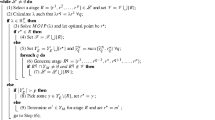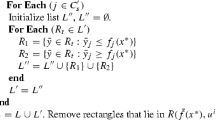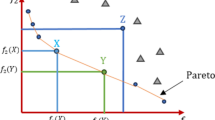Abstract
Nadir points play an important role in many-objective optimization problems, which describe the ranges of their Pareto fronts. Using nadir points as references, decision makers may obtain their preference information for many-objective optimization problems. As the number of objectives increases, nadir point estimation becomes a more difficult task. In this paper, we propose a novel nadir point estimation method based on emphasized critical regions for many-objective optimization problems. It maintains the non-dominated solutions near extreme points and critical regions after an individual number assignment to different critical regions. Furthermore, it eliminates similar individuals by a novel self-adaptive \(\varepsilon \)-clearing strategy. Our approach has been shown to perform better on many-objective optimization problems (between 10 objectives and 35 objectives) than two other state-of-the-art nadir point estimation approaches.









Similar content being viewed by others
References
Amiri M, Ekhtiari M, Yazdani M (2010) Nadir compromise programming: a model for optimization of multi-objective portfolio problem. Expert Syst Appl 36(6):7222–7226
Bechikh S, Ben Said L, Ghedira K (2010) Estimating nadir point in multi-objective optimization using mobile reference points. In: Evolutionary computation (CEC), 2010 IEEE congress on, IEEE Press, pp 1–9
Ben Said L, Bechikh S, Ghédira K (2010) The r-dominance: a new dominance relation for interactive evolutionary multicriteria decision making. IEEE Trans Evol Comput 14(5):801–818
Benayoun R, De Montgolfier J, Tergny J, Laritchev O (1971) Linear programming with multiple objective functions: step method (STEM). Math Program 1(1):366–375
Branke J, Kaußler T, Smidt C, Schmeck H (2000) A multi-population approach to dynamic optimization problems. In: Evolutionary design and manufacture. Springer, pp 299–307
Branke J, Deb K, Dierolf H, Osswald M (2004) Finding knees in multi-objective optimization. In: Parallel problem solving from nature-PPSN VIII. Springer, pp 722–731
Branke J, Deb K, Miettinen K (2008) Multiobjective optimization: interactive and evolutionary approaches. Springer, New York
Chen N, Chen WN, Gong YJ, Zhan ZH, Zhang J, Li Y, Tan YS (2015) An evolutionary algorithm with double-level archives for multiobjective optimization. IEEE Trans Cybern 45(9):1851–1863
Dai J, Wang W, Xu Q (2013) An uncertainty measure for incomplete decision tables and its applications. IEEE Trans Cybern 43(4):1277–1289
Deb K, Jain H (2014) An evolutionary many-objective optimization algorithm using reference-point-based nondominated sorting approach, part i: solving problems with box constraints. IEEE Trans Evol Comput 18(4):577–601
Deb K, Kumar A (2007) Interactive evolutionary multi-objective optimization and decision-making using reference direction method. In: Proceedings of the genetic and evolutionary computation conference (GECCO 2007). ACM Press, pp 781–788
Deb K, Miettinen K (2009) A review of nadir point estimation procedures using evolutionary approaches: a tale of dimensionality reduction. In: Proceedings of the multiple criterion decision making (MCDM-2008) conference. Springer, pp 1–14
Deb K, Pratap A, Agarwal S, Meyarivan T (2002a) A fast and elitist multiobjective genetic algorithm: NSGA-II. IEEE Trans Evol Comput 6(2):182–197
Deb K, Thiele L, Laumanns M, Zitzler E (2002b) Scalable multi-objective optimization test problems. In: Evolutionary computation (CEC), 2002 IEEE congress on, vol 1. IEEE Press, pp 825–830
Deb K, Chaudhuri S, Miettinen K (2006) Towards estimating nadir objective vector using evolutionary approaches. In: Proceedings of the genetic and evolutionary computation conference (GECCO 2006). ACM Press, pp 643–650
Deb K, Miettinen K, Sharma D (2009) A hybrid integrated multi-objective optimization procedure for estimating nadir point. In: Evolutionary multi-criterion optimization. Springer, pp 569–583
Deb K, Miettinen K, Chaudhuri S (2010) Toward an estimation of nadir objective vector using a hybrid of evolutionary and local search approaches. IEEE Trans Evol Comput 14(6):821–841
Derrac J, García S, Molina D, Herrera F (2011) A practical tutorial on the use of nonparametric statistical tests as a methodology for comparing evolutionary and swarm intelligence algorithms. Swarm Evol Comput 1(1):3–18
Dessouky M, Ghiassi M, Davis W (1986) Estimates of the minimum nondominated criterion values in multiple-criteria decision-making. Eng Costs Prod Econ 10(1):95–104
Ehrgott M, Tenfelde-Podehl D (2003) Computation of ideal and nadir values and implications for their use in MCDM methods. Eur J Oper Res 151(1):119–139
Fan Z, Liu Y (2010) A method for group decision-making based on multi-granularity uncertain linguistic information. Expert Syst Appl 37(5):4000–4008
He Y, He Z, Chen H (2015) Intuitionistic fuzzy interaction bonferroni means and its application to multiple attribute decision making. IEEE Trans Cybern 45(1):116–128
Hsu S, Wang T (2011) Solving multi-criteria decision making with incomplete linguistic preference relations. Expert Syst Appl 38(9):10882–10888
Huband S, Hingston P, Barone L, While L (2006) A review of multiobjective test problems and a scalable test problem toolkit. IEEE Trans Evol Comput 10(5):477–506
Hughes E (2005) Evolutionary many-objective optimisation: many once or one many? In: Evolutionary computation (CEC), 2005 IEEE congress on, vol 1. IEEE Press, pp 222–227
Ishibuchi H, Tsukamoto N, Nojima Y (2008) Evolutionary many-objective optimization: a short review. In: Evolutionary computation (CEC), 2008 IEEE congress on. IEEE Press, pp 2419–2426
Ishibuchi H, Masuda H, Tanigaki Y, Nojima Y (2014) Review of coevolutionary developments of evolutionary multi-objective and many-objective algorithms and test problems. In: Computational intelligence in multi-criteria decision-making (MCDM), 2014 IEEE symposium on. IEEE, pp 178–184
Jiang S, Ong YS, Zhang J, Feng L (2014) Consistencies and contradictions of performance metrics in multiobjective optimization. IEEE Trans Cybern 44(12):2391–2404
Ke L, Zhang Q, Battiti R (2013) MOEA/D-ACO: a multiobjective evolutionary algorithm using decomposition and antcolony. IEEE Trans Cybern 43(6):1845–1859
Khare V, Yao X, Deb K (2003) Performance scaling of multi-objective evolutionary algorithms. In: Fonseca C, Fleming P, Zitzler E, Thiele L, Deb K (eds) Evolutionary multi-criterion optimization. Lecture notes in computer science, vol 2632. Springer, Berlin, pp 376–390
Klamroth K, Miettinen K (2008) Integrating approximation and interactive decision making in multicriteria optimization. Oper Res 56(1):222–234
Korhonen P, Salo S, Steuer R (1997) A heuristic for estimating nadir criterion values in multiple objective linear programming. Oper Res 45(5):751–757
Li K, Kwong S, Zhang Q, Deb K (2015) Interrelationship-based selection for decomposition multiobjective optimization. IEEE Trans Cybern 45(10):2076–2088
Ma X, liu f, Qi Y, Wang X, Li L, Jiao L, Yin M, Gong M (2015) A multiobjective evolutionary algorithm based on decision variable analyses for multi-objective optimization problems with large scale variables. IEEE Trans Evolut Comput PP(99):1–1. doi:10.1109/TEVC.2015.2455812
Metev B, Vassilev V (2003) A method for nadir point estimation in MOLP problems. Cybern Inf Technol 3(2):15–24
Miettinen K (1999) Nonlinear multiobjective optimization. Springer, New York
Miettinen K, Eskelinen P, Ruiz F, Luque M (2010) NAUTILUS method: an interactive technique in multiobjective optimization based on the nadir point. Eur J Oper Res 206(2):426–434
Praditwong K, Yao X (2006) A new multi-objective evolutionary optimisation algorithm: the two-archive algorithm. In: Computational intelligence and security, 2006 international conference on, vol 1. IEEE Press, pp 286–291
Praditwong K, Yao X (2007) How well do multi-objective evolutionary algorithms scale to large problems. In: Evolutionary computation (CEC), 2007 IEEE congress on. IEEE Press, pp 3959–3966
Purshouse R, Fleming P (2003) Evolutionary many-objective optimisation: an exploratory analysis. In: Evolutionary computation (CEC), 2003 IEEE congress on, vol 3. IEEE Press, pp 2066–2073
Szczepanski M, Wierzbicki A (2003) Application of multiple criteria evolutionary algorithms to vector optimisation, decision support and reference point approaches. J Telecommun Inf Technol 3:16–33
Thiele L, Miettinen K, Korhonen P, Molina J (2009) A preference-based evolutionary algorithm for multi-objective optimization. Evol Comput 17(3):411–436
Wang H, Jiao L, Yao X (2015) Two\_Arch2: an improved two-archive algorithm for many-objective optimization. IEEE Trans Evol Comput 19(4):524–541
Yuan Y, Xu H, Wang B, Yao X (2015a) A new dominance relation based evolutionary algorithm for many-objective optimization. doi:10.1109/TEVC.2015.2420112
Yuan Y, Xu H, Wang B, Zhang B, Yao X (2015b) Balancing convergence and diversity in decomposition-based many-objective optimizers. doi:10.1109/TEVC.2015.2443001
Zitzler E, Künzli S (2004) Indicator-based selection in multiobjective search. In: Parallel problem solving from nature-PPSN VIII. Springer, pp 832–842
Zitzler E, Thiele L (1999) Multiobjective evolutionary algorithms: a comparative case study and the strength pareto approach. IEEE Trans Evol Comput 3(4):257–271
Zitzler E, Deb K, Thiele L (2000) Comparison of multiobjective evolutionary algorithms: empirical results. Evol Comput 8(2):173–195
Acknowledgments
This work was supported by the National Basic Research Program (973 Program) of China (No.2013CB329402), an EPSRC Grant (No. EP/J017515/1) on “DAASE: Dynamic Adaptive Automated Software Engineering”, the Program for Cheung Kong Scholars and Innovative Research Team in University (No. IRT1170), the National Natural Science Foundation of China (No. 61329302), National Science Foundation of China (Nos. 91438103 and 91438201), and the Fund for Foreign Scholars in University Research and Teaching Programs (the 111 Project) (No. B07048). Xin Yao was supported by a Royal Society Wolfson Research Merit Award.
Author information
Authors and Affiliations
Corresponding author
Ethics declarations
Conflict of interest
The authors declared that they have no conflicts of interest to this work.
Additional information
Communicated by V. Loia.
Rights and permissions
About this article
Cite this article
Wang, H., He, S. & Yao, X. Nadir point estimation for many-objective optimization problems based on emphasized critical regions. Soft Comput 21, 2283–2295 (2017). https://doi.org/10.1007/s00500-015-1940-x
Published:
Issue Date:
DOI: https://doi.org/10.1007/s00500-015-1940-x




